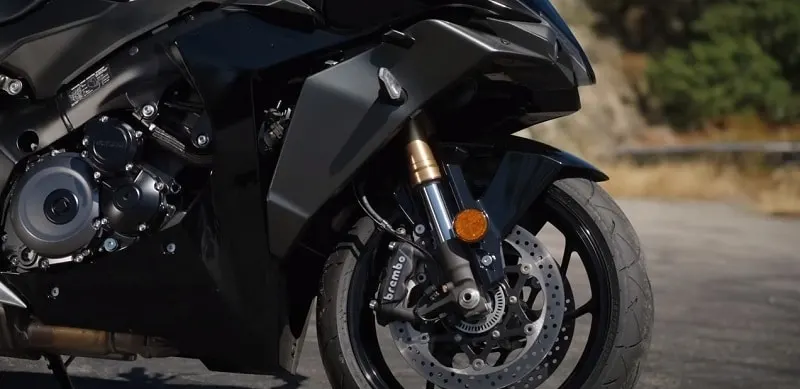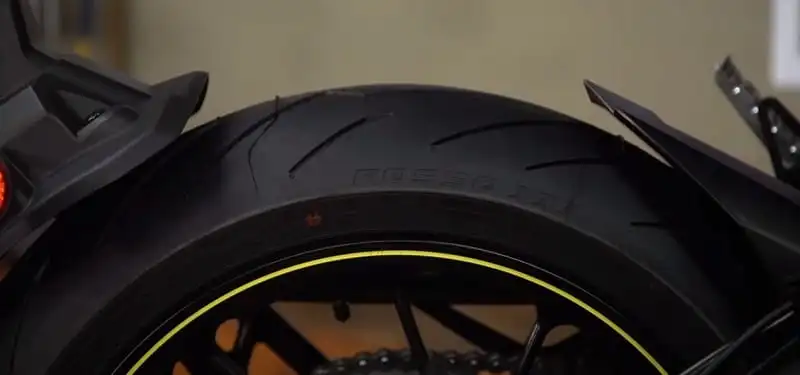Tires are essential components of any vehicle, providing traction and ensuring safe handling.
Motorcycle tires wear out much faster than automobile tires, raising questions about why this disparity exists.
Motorcycle tires wear out faster than automobile tires due to their softer and stickier rubber compounds, designed to provide more grip. Additionally, motorcycles have a higher power-to-weight ratio and travel at higher speeds, resulting in a smaller contact footprint for the tire.
To tackle this problem is like unraveling a Gordian knot; you must first understand the underlying principles of tire construction and performance before attempting to explain why motorcycle tires wear out so quickly.
This article delves into the science behind motorcycle tire durability, exploring the factors that lead to their rapid deterioration – an eye-opening revelation for all riders!

Why Motorcycle Tires Wear Out Faster Than Automobiles
Quality And Type Of Tires
Motorcycle tires are uniquely exposed to a range of conditions that can cause them to wear faster than automobile tires.
Motorcycles have significant weight, power, and torque concentrated in their small tire contact patches.
This combination decreases the longevity of motorcycle tires compared to automobile tires due to higher friction during cornering, braking, and acceleration.
Motorcycle tires also tend to be softer and stickier than auto tires, contributing to faster wear rates.
The quality and type of the tire are other major factors when it comes to motorcycle tire wear.
Low-grade or low-cost tires often lack the durability needed for long-lasting performance on a motorcycle, leading to shorter service life even under normal operating conditions.
Moreover, aggressive street riding can place tremendous strain on any motorcycle tire, making it more vulnerable to damage from abrasion and punctures.
On the other hand, high-performance race-type slicks with harder rubber compounds may last longer but offer less grip in wet or slippery conditions, which could lead to dangerous situations while riding.
For a rider to get optimal performance from their bike’s tires, they must choose the right balance between durability and traction depending on their own riding style as well as road surface characteristics such as temperature, surface texture, moisture levels, etc.
With proper selection based on these factors, you should be able to maximize mileage without compromising the safety or handling capabilities of the vehicle.
Type Of Motorcycle
Riding a motorcycle can be an exhilarating experience, and the right type of tire is key to getting the most out of it.
When considering why motorcycle tires wear out so much faster, you must look at what makes them different.
A figure of speech could describe this as “the devil being in the details” – something motorbike riders are all too familiar with!
This section will explore how the type of motorcycle has a direct impact on how quickly its tires wear down:
Secondly, touring motorcycles require more road surface contact resulting in higher tread wear over time.
Thirdly, scooters use smaller wheels that rotate faster, therefore, wearing away the rubber faster than larger automobile tires.
Fourthly, cruisers tend to have heavier frames, putting extra strain on the entire bike, particularly on the tires themselves.
And finally, dirt bikes often employ knobby or off-road style tires with thicker treads; although they may last longer under normal circumstances, they need replacing sooner when used on paved roads regularly.
The fact remains that regardless of type or design, all motorcycle tires only last for a short time as those found in automobiles due to their greater exposure to friction and other external forces.
The above points provide insight into why certain motorbikes might incur additional tire deterioration depending on their usage patterns and riding conditions.
In summary, while many factors are involved when comparing bicycle versus automobile wheel longevity, understanding each vehicle’s specific needs goes a long way toward ensuring optimal performance from both your machine and its accompanying parts.
Riding Habits
Motorcycles are typically driven with a heavier emphasis on acceleration and braking, as opposed to automobiles, which are driven at a more steady pace.
This aggressive riding style puts added pressure on the tire treads – leading them to deteriorate quickly over time. Additionally, due to their size, motorcycles have softer tires compared to automobiles making them more vulnerable to wear and tear from regular use.
Another contributing factor towards fast-wearing motorcycle tires could be the vehicle’s speed.
Motorcycles can travel significantly faster than most automobiles, resulting in increased friction between the surface of the road and the rubber compound of the tire – causing it to degrade faster.
As such, riders should take precautions if they wish for their tires to last longer, such as limiting excessive speeds or avoiding sudden accelerations whenever possible.
Ultimately, riding habits and speed play an important role in how long motorcycle tires will endure before needing replacement.
Understanding how these factors affect the fast wearing of motorcycle tires gives insight into why they need replacing so often – informing riders about preventive measures that can be taken for their vehicles’ tires to stay safe and rideable for longer periods.
Tire Age
The tread on a tire acts as the primary defense against road elements, providing grip and preventing skidding or slipping.
Over time, however, these essential treads begin to diminish in quality due to exposure to the many harsh conditions of the open roads.
As this happens, it leads to increased tire wear and can ultimately render a set of tires useless if left unchecked.
The key to avoiding excessive tire wear lies in regular maintenance and inspection of the tire’s condition.
You can ensure maximum longevity from your bike’s rubber parts by ensuring that your tires are properly inflated at all times.
Additionally, checking for any signs of balding or cracking periodically will help prolong their lifespan significantly by alerting you to potential risks before they become hazardous.
Ultimately, proper tire pressure management and regular inspections can be the difference between safe riding and dangerous situations caused by worn-out tires.
Taking extra care with how you operate your vehicle, along with periodic checks, will go a long way towards preserving your tires so that you don’t have to worry about replacing them sooner than necessary.
Road Conditions
When it comes to tire wear, motorcycle tires are particularly vulnerable due to the heavy loads they carry and the road conditions they often traverse.
Miles of sport-touring tires on a single set can wear out faster than automobile tires in just a fraction of the time.
To illustrate this phenomenon, imagine an old-fashioned carthorse being ridden by a child—the horse is subjected to more weight per square inch than its four feet were designed for and, after only so many turns around the circle, begins to show signs of fatigue.
This same concept applies to motorcycles: because their tires are exposed to greater forces from acceleration and cornering as well as environmental factors like potholes or mud patches, wearing motorcycle tires can be expected at much higher mileage thresholds.
In terms of speed and agility, motorcyclists benefit from having lower rolling resistance when compared with automobiles; however, this trait also makes them susceptible to increased heat buildup, which accelerates rubber deterioration.
Furthermore, since most bikes have thinner sidewalls than automobiles do – allowing for better handling – there’s less protection against debris that could puncture or tear into the tread itself.
The combination of these two elements means that riders must pay close attention to their bike’s tire pressures while simultaneously replacing worn parts regularly ahead of any unexpected failures occurring on the road while traveling at high speeds.
The need for frequent maintenance has been compounded even further by recent technological advances, such as electronic suspension systems, which require additional care during use to not compromise rider safety due to excessive tire wear.
As such, understanding how different riding styles affect tire life is paramount if one wishes to maximize both performance and longevity before needing new replacements down the line.
With proper maintenance protocols followed and regular checks conducted over time, motorcyclists will find themselves always prepared whenever hitting the open roads again.
Maintenance

Proper maintenance is essential for ensuring the longevity of motorcycle tires, and it can be likened to ‘an ounce of prevention’. Tire size, type, and riding habits all play important roles in preserving tire life.
Motorcycle tires are smaller than automobiles, so they are more susceptible to damage from road conditions such as potholes.
The smaller width also creates less surface area contact with the ground, resulting in increased pressure on each square inch compared to auto tires with greater surface area contact with the ground.
Additionally, motorcycle tires are designed differently than automobile tires; most motorcycles use bias-ply or radial construction, which makes them softer and provides better grip but at the cost of faster deterioration versus auto tires which tend to last longer because their design allows for greater tread depth and improved durability.
Finally, riding habits also contribute significantly to tire wear since riders may take corners faster or brake more abruptly than an automobile operator would – both result in accelerated tire wear.
Therefore, proper care should be taken while operating a motorcycle by avoiding excessive acceleration or braking too hard so as not to compromise the integrity of the tire components prematurely.
In addition, regular inspections and timely replacements based on the manufacturer’s recommendations will help keep your motorcycle running smoothly while providing extra safety measures on the road.
Conclusion
The life of motorcycle tires can vary greatly depending on the type, quality, and age of a tire, as well as road conditions, riding habits, and maintenance.
Motorcycle tires wear out much faster than automobile tires for these reasons.
Tires designed for motorcycles are typically made from a softer rubber compound than those used in automobiles.
This allows for greater grip during cornering and increases their wear rate compared to automobile tires.
The type of motorcycle can impact how quickly its tires will wear down because some bikes require more power, leading to higher levels of friction between the bike and the pavement.
Furthermore, riders’ habits play a role in accelerated tire degradation, with aggressive acceleration or braking causing additional pressure on certain points of treads, increasing their rate of deterioration over time.
Road conditions such as gravel or uneven surfaces add extra stress onto already worn-down treads resulting in increased damage.
Finally, regular maintenance is required if one wishes to prolong the life of his/her tires.
To maximize the lifespan of any set of motorcycle tires, it is important to purchase good quality products from reliable brands, ride responsibly following speed limits and traffic rules, avoid rough roads where possible, check regularly for signs of excessive wear or damage, and maintain correct air pressures at all times.
By taking these precautions, one should be able to enjoy longer usage periods with minimal hassle or cost associated with frequent replacements due to premature tire failure.
Previous Article: Should You Rotate Motorcycle Tires?
Next Article: Why Motorcycle Tires Have Little Tread

